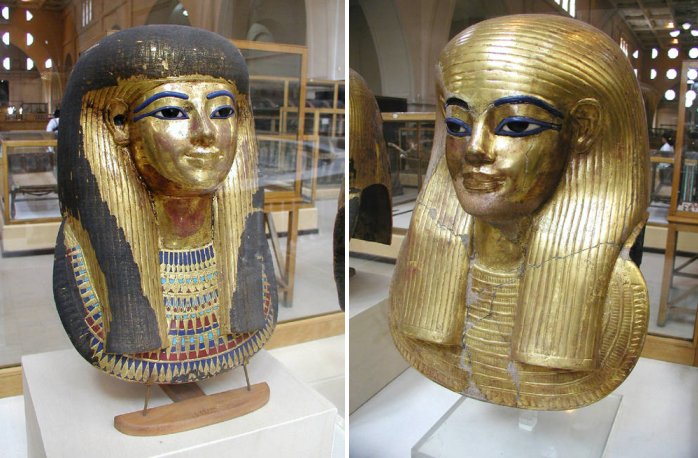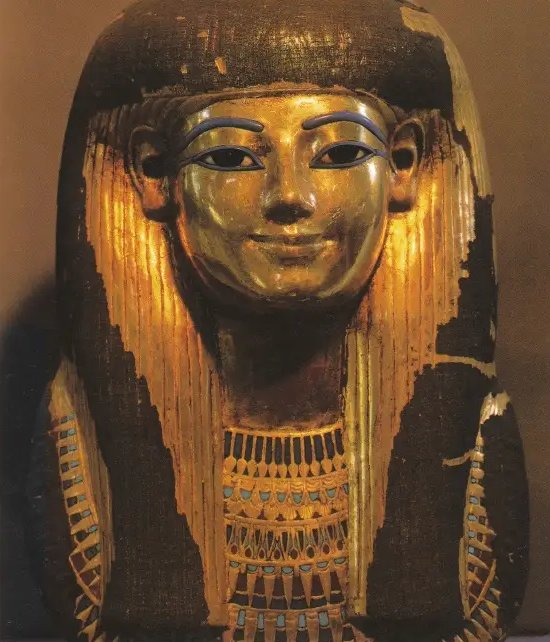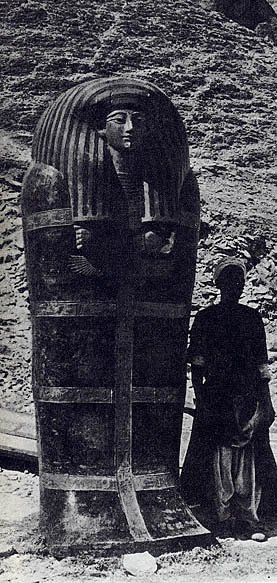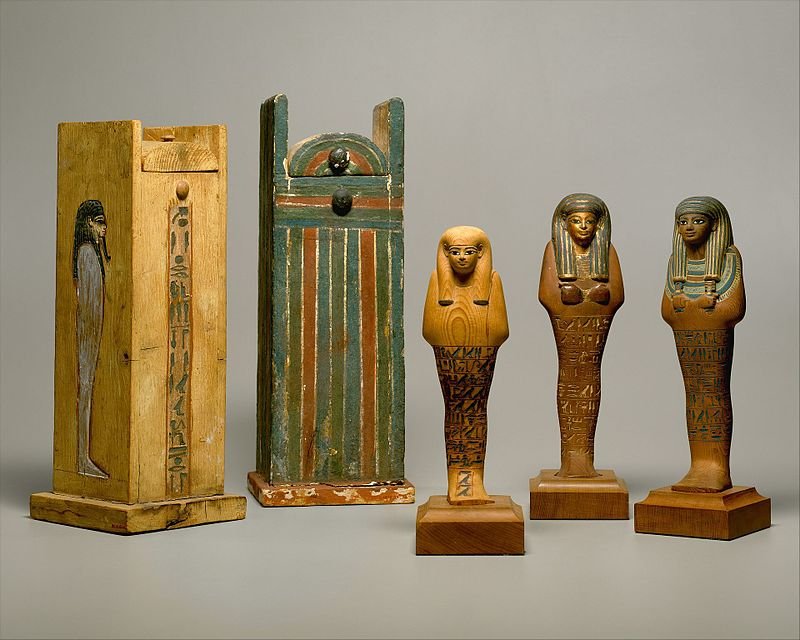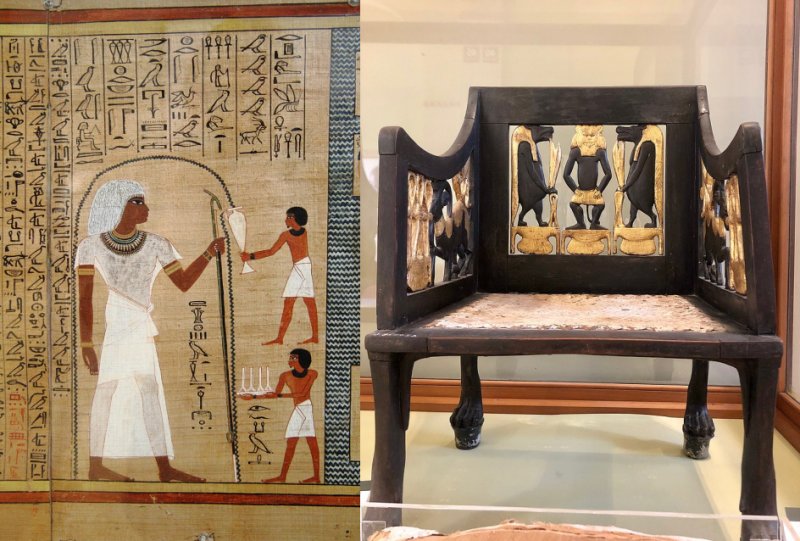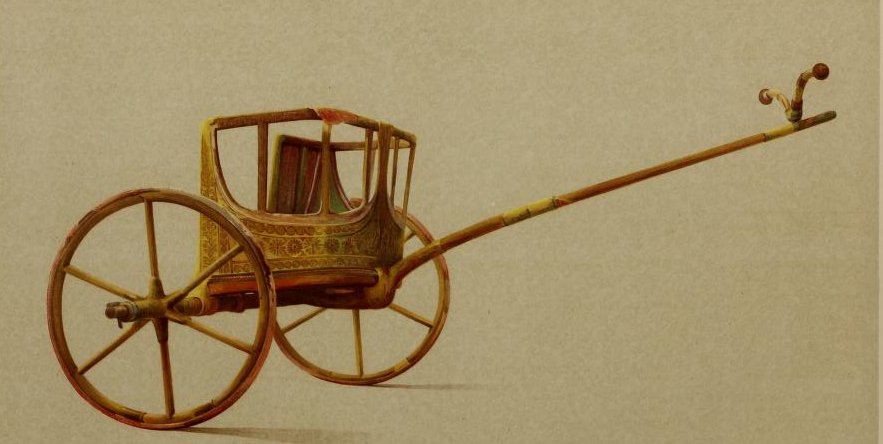Amazing Tomb Of Yuya And Tjuyu Filled With Ancient Treasures In The Valley Of The Kings
Ellen Lloyd - AncientPages.com - Many amazing archaeological discoveries have been made in the Land of The Pharaohs. Still, archaeologists cannot often find nearly intact burials filled with the most extraordinary ancient treasures left untouched for three thousand years.
Left: Mummy mask of Tjuyu - Credit: Jon Bodsworth - Right: Mummy mask of Yuya - Credit: Jon Bodsworth
The Egyptian couple Yuya and Tjuyu were less important historical individuals. They gained historians' attention because they were the parents of Queen Tiye, the mother of Akhenaten. After their death, years passed, and perhaps Yuya and Tjuyu would have been forgotten. Still, the discovery of their great tomb in the Valley of the Kings gave them a prominent place in historical and archaeological records.
Most ancient Egyptian tombs have been looted, but few thieves had the opportunity to enter Yuya and Tjuyu's tomb, KV46. Their graves escaped serious robbery because this burial place was protected by construction debris.
Who Was Yuya and Tjuyu?
Yuya and his wife Tjuyu lived during the Eighteenth Dynasty of Egypt (circa 1390 BC). Yuya was a powerful ancient Egyptian courtier, and Tjuyu was a noblewoman. She was also known under other names like Touiyou, Thuiu, Thuya or Thuyu.
They were parents of Queen Tiye and Anen, a priest of Heliopolis, and acquired the title Divine Father. 1
Gilded cartonnage mask of the Lady Tjuyu. Credit: Nicholas Reeves, Richard H. Wilkinson
When Yuya and Tjuyu died, somebody put them to rest following ancient Egyptian burial traditions. Their bodies were prepared for the afterlife and provided various funerary goods.
Ancient Egyptians did not consider death to be the end of our existence. To them, death was merely "a transition to another reality."
For many Egyptians, eternal life consisted of traveling with the sun during the day and returning to the well-stocked tomb in the evening. To make this possible, it was essential to make embalming, mummification, building tombs, and perform other rituals to help the deceased experience eternal peace." 2
Studies of the mummified remains of Yuya and Tjuyu suggest they died at a relatively advanced age. Their hair was white, and the examination of their remains did not contradict the verdict of their hair." According to archaeologists who excavated KV46 it would "not be a mistake to state that they had reached an age over sixty. From the relative position of the two sarcophagi in the tomb, it seems that the husband was the first to die, but material is lacking to decide this question." 3
The Discover Of Yuya And Tjuyu 's Tomb In The Valley Of The Kings
The Valley of the Kings, located on the Nile's west bank near Luxor, was used for burials from approximately 1539 B.C. to 1075 B.C. Before the discovery of King Tutankhamun's tomb in 1922, the tomb of Yuya and Tjuyu was one of the most celebrated discoveries in Egyptian archaeology.
An Egyptian excavator beside the outer coffin of Yuya. Credit: Public Domain
The private tomb of Yuya and Tjuyu, located between KV3 and KV4, was discovered in 1905 by James E. Quibell under the sponsorship of Theodore M. Davis.
When archaeologists entered KV46, they were amazed to see many beautiful, well-preserved ancient objects.
"The outer doorway 'was closed within eighteen inches of the top with flat stones, about twelve inches by four, laid in Nile mud plaster'… This wall 'plastered over with mud and stamped in many places with the jackal-and-nine captives seal, displayed an opening in the top right-hand corner, at chin height – so clearly, it was not an intact tomb.
Shabti and shabti boxes of Yuya, now in the Metropolitan Museum of Art - Image source: Metropolitan Museum of Art
Beyond lay a corridor, empty save for a few stray items, leading down to a second blocking, stamped with the seal of the necropolis administration but likewise broken through at the top. On the floor, at the base of the wall, were two pottery bowls containing dried mud – evidence, perhaps, of small-scale plastering work undertaken following the first period of theft – and the sticks used to apply it." 4
When the excavators peered over the wall, an eerie sight met their eyes:
"Imagine entering a townhouse which had been closed for the summer: imagine the stuffy room, the stiff silent appearance of the furniture, the feeling that some ghostly occupants of the vacant chairs have just been disturbed, the desire to throw open the windows to let life into the room once more. That was perhaps the first sensation as we stood, really dumbfounded, and stared around at the relics of the life of over three thousand years ago," Arthur Weigall, who participated in the excavation of KV46, recalled.
When archaeologists entered KV46, due to its sealed environment, it still had silver shining brightly. As soon as scientists opened the tomb, everything turned black.
Left: Vignette of Yuya from his Book of the Dead. Credit: Djehouty - CC BY-SA 4.0 - Right: The gilded 'ibex' chair - Credit: Warren LeMay
Three thousand-year-old vessels with thick liquid oil and honey still preserved the scent. The mummies of Yuya and Tjuyu were also in excellent condition. The mummy of Yuya "was enclosed in three separate coffins, nested one within the other. These again were placed in a large rectangular wooden sarcophagus, the latter being mounted on a sledge with roller in front." 3
The coffins were covered with hieroglyphs, and images showed a procession of gods led by Thoth.
Tjuyu has also been placed in "two separate coffins, one within the other, and placed in a large rectangular wooden sarcophagus mounted on a sledge." 3
Inside KV46, archaeologists found magnificent jewelry, the Book of the Dead, and several canopic jars.
Still, of all the magnificent ancient objects in KV46, the well-preserved chariot was the most extraordinary.
Magnificent chariot found in the tomb of Yuya and Tjuyu. Credit: Davis, Theodore M
Beautifully decorated with spirals and rosettes in gild plaster, the nameless chariot most likely belonged to Yuya.
"In it nearly perfect preservation: the framework of the body, the wheels, and the pole are intact, and even the leather-work which has been stripped from the sides of the "body" has been found and could be put back in place. It is doubtful whether it was used except for the funeral procession, for the leather types are hardly scratched." 3
The unique archaeological treasures discovered in Yuya and Tjuyu's tomb give us an essential glimpse into ancient Egyptian history, traditions, and religious beliefs.
Written by Ellen Lloyd – AncientPages.com
Updated on Sep 26, 2023
Copyright © AncientPages.com All rights reserved. This material may not be published, broadcast, rewritten or redistributed in whole or part without the express written permission of AncientPages.com
Expand for references- Dodson, Aidan; Hilton, Dyan - The Complete Royal Families of Ancient Egypt
- Sutherland - Death And Afterlife In Ancient Egyptian Beliefs – Death As Transition To Another Reality, AncientPages.com
- Davis, Theodore M., Maspero, G., Newberry, Percy E., Carter, Howard - The Tomb Of Iouiya And Touiyou: The Finding Of The Tomb
- Nicholas Reeves, Richard H. Wilkinson - The Complete Valley of the Kings: Tombs and Treasures of Ancient Egypt's Royal Burial Site
More From Ancient Pages
-
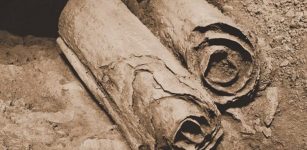 Qumran: The Dead Sea Scrolls And Their Connection To Enigmatic Essenes
Civilizations | Feb 20, 2016
Qumran: The Dead Sea Scrolls And Their Connection To Enigmatic Essenes
Civilizations | Feb 20, 2016 -
 Change Of Burial Tradition Among The People of Early Medieval Europe
Archaeology | Aug 6, 2021
Change Of Burial Tradition Among The People of Early Medieval Europe
Archaeology | Aug 6, 2021 -
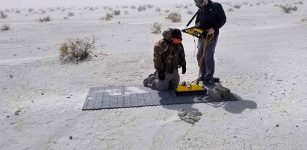 Radar Reveals ‘Ghost’ Footprints From Pleistocene Era
Archaeology | Nov 13, 2019
Radar Reveals ‘Ghost’ Footprints From Pleistocene Era
Archaeology | Nov 13, 2019 -
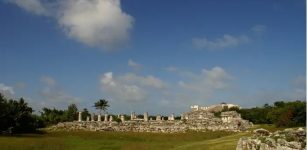 Immigrants In Prehispanic Cancun Were Treated Just Like Maya Locals
Archaeology | Oct 26, 2023
Immigrants In Prehispanic Cancun Were Treated Just Like Maya Locals
Archaeology | Oct 26, 2023 -
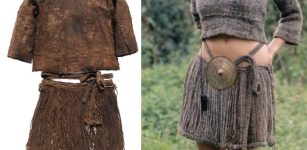 Egtved Girl’s Unique 3,400-Year-Old Style Of Dress
Featured Stories | Nov 17, 2023
Egtved Girl’s Unique 3,400-Year-Old Style Of Dress
Featured Stories | Nov 17, 2023 -
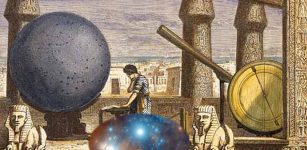 Ancient Egyptians Observed Algol’s Eclipses – Cairo Calendar Analyzed
Archaeology | Dec 19, 2015
Ancient Egyptians Observed Algol’s Eclipses – Cairo Calendar Analyzed
Archaeology | Dec 19, 2015 -
 Was Tintagel Castle A Fortress Used By Iconic Hero King Arthur?
Featured Stories | Mar 12, 2016
Was Tintagel Castle A Fortress Used By Iconic Hero King Arthur?
Featured Stories | Mar 12, 2016 -
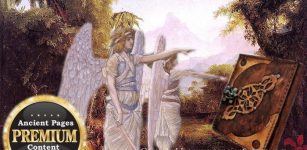 Precious Lost Ancient Book Of Wisdom Could Solve Biblical Mysteries
Artifacts | Nov 26, 2018
Precious Lost Ancient Book Of Wisdom Could Solve Biblical Mysteries
Artifacts | Nov 26, 2018 -
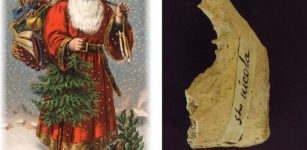 Examined Ancient Bone Suggests Santa Claus Was Real
Archaeology | Dec 8, 2017
Examined Ancient Bone Suggests Santa Claus Was Real
Archaeology | Dec 8, 2017 -
 Code Of Chivalry: ‘Knightly’ Behavior, Courageous Medieval Knights, Warriors And Superior Men
Featured Stories | Jun 5, 2016
Code Of Chivalry: ‘Knightly’ Behavior, Courageous Medieval Knights, Warriors And Superior Men
Featured Stories | Jun 5, 2016 -
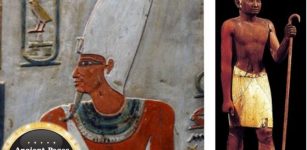 Mysterious Ancient Rulers With Elongated Skulls – Who Were They Really?
Featured Stories | May 19, 2015
Mysterious Ancient Rulers With Elongated Skulls – Who Were They Really?
Featured Stories | May 19, 2015 -
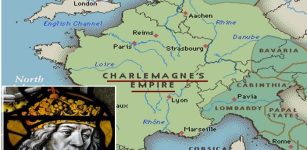 On This Day In History: Charlemagne Became The King Of The Franks – On Dec 5, 771
News | Dec 5, 2016
On This Day In History: Charlemagne Became The King Of The Franks – On Dec 5, 771
News | Dec 5, 2016 -
 Secrets Of Viking Age Shields Finally Revealed
Civilizations | Oct 7, 2020
Secrets Of Viking Age Shields Finally Revealed
Civilizations | Oct 7, 2020 -
 Bizarre And Unexplained Phenomenon That Defied The Laws Of Nature
Featured Stories | May 12, 2018
Bizarre And Unexplained Phenomenon That Defied The Laws Of Nature
Featured Stories | May 12, 2018 -
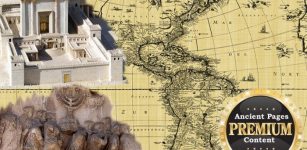 Traces Of Ancient Near East Civilization In America – An Out-Of-Place Ancient Inscription – Part 2
Civilizations | Nov 13, 2020
Traces Of Ancient Near East Civilization In America – An Out-Of-Place Ancient Inscription – Part 2
Civilizations | Nov 13, 2020 -
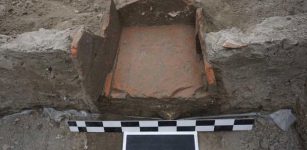 Ancient ‘Refrigerator’ And Unique Coins Discovered In Roman Military Camp In Bulgaria
Archaeology | Oct 3, 2022
Ancient ‘Refrigerator’ And Unique Coins Discovered In Roman Military Camp In Bulgaria
Archaeology | Oct 3, 2022 -
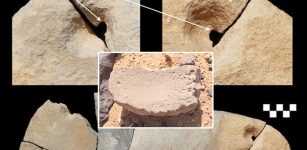 Study: Grinding Tools Were Once Used In Plant, Pigment And Bone Processing At Jebel Oraf Site, Saudi Arabia
Archaeology | Oct 6, 2023
Study: Grinding Tools Were Once Used In Plant, Pigment And Bone Processing At Jebel Oraf Site, Saudi Arabia
Archaeology | Oct 6, 2023 -
 Long-Lost Island Documented On Ancient Maps – Erased From History Or Misidentified?
Featured Stories | Dec 14, 2019
Long-Lost Island Documented On Ancient Maps – Erased From History Or Misidentified?
Featured Stories | Dec 14, 2019 -
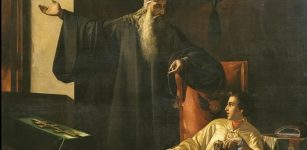 On This Day In History: Terrible Day In Moscow Engulfed By Fire – On June 21, 1547
News | Jun 20, 2016
On This Day In History: Terrible Day In Moscow Engulfed By Fire – On June 21, 1547
News | Jun 20, 2016 -
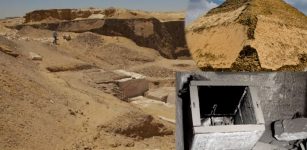 Mystery Of The Unbreached Burial Chamber Inside A Little-Known Pyramid In The Dashur Complex
Featured Stories | Mar 18, 2022
Mystery Of The Unbreached Burial Chamber Inside A Little-Known Pyramid In The Dashur Complex
Featured Stories | Mar 18, 2022

